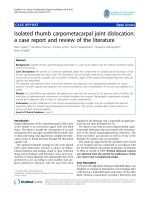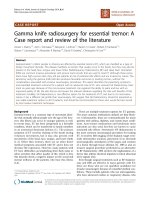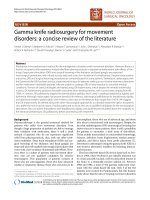Báo cáo khoa học: "Gamma Knife radiosurgery for vestibular schwannoma: case report and review of the literature" pptx
Bạn đang xem bản rút gọn của tài liệu. Xem và tải ngay bản đầy đủ của tài liệu tại đây (419.04 KB, 6 trang )
BioMed Central
Page 1 of 6
(page number not for citation purposes)
World Journal of Surgical Oncology
Open Access
Case report
Gamma Knife radiosurgery for vestibular schwannoma: case report
and review of the literature
Benjamin J Arthurs
1,2
, Wayne T Lamoreaux
1,3
, Neil A Giddings
1,4
,
Robert K Fairbanks
1,3
, Alexander R Mackay
1,5
, John J Demakas
1,6
,
Barton S Cooke
1
and Christopher M Lee*
1,3
Address:
1
Gamma Knife of Spokane, 910 W 5th Ave, Suite 102, Spokane, WA 99204, USA,
2
University of Washington School of Medicine, Seattle,
WA, USA,
3
Cancer Care Northwest, 910 W 5th Ave, Suite 102, Spokane, WA 99204, USA,
4
Spokane Ear Nose & Throat Clinic, 217 W Cataldo Ave,
Spokane, WA 99201, USA,
5
Mackay & Meyer MDs, 711 S Cowley St, Suite 210, Spokane, WA 99202, USA and
6
Spokane Brain & Spine, 801 W 5th
Ave, Suite 210, Spokane, WA 99204, USA
Email: Benjamin J Arthurs - ; Wayne T Lamoreaux - ;
Neil A Giddings - ; Robert K Fairbanks - ; Alexander R Mackay - ;
John J Demakas - ; Barton S Cooke - ; Christopher M Lee* -
* Corresponding author
Abstract
Vestibular schwannomas, also called acoustic neuromas, are benign tumors of the
vestibulocochlear nerve. Patients with these tumours almost always present with signs of hearing
loss, and many also experience tinnitus, vertigo, and equilibrium problems. Following diagnosis with
contrast enhanced MRI, patients may choose to observe the tumour with subsequent scans or seek
active treatment in the form of microsurgery, radiosurgery, or radiotherapy. Unfortunately,
definitive guidelines for treating vestibular schwannomas are lacking, because of insufficient
evidence comparing the outcomes of therapeutic modalities.
We present a contemporary case report, describing the finding of a vestibular schwannoma in a
patient who presented with dizziness and a "clicking" sensation in the ear, but no hearing deficit.
Audible clicking is a symptom that, to our knowledge, has not been associated with vestibular
schwannoma in the literature. We discuss the diagnosis and patient's decision-making process,
which led to treatment with Gamma Knife radiosurgery. Treatment resulted in an excellent
radiographic response and complete hearing preservation. This case highlights an atypical
presentation of vestibular schwannoma, associated with audible "clicks" and normal hearing. We
also provide a concise review of the available literature on modern vestibular schwannoma
treatment, which may be useful in guiding treatment decisions.
Background
Vestibular schwannomas (VS), or acoustic neuromas, are
benign neoplasms of the myelin-forming Schwann cells
of the vestibulocochlear nerve. They arise commonly
within the internal auditory meatus, and may extend into
the cerebellopontine angle. Reported incidence is 1 per
100,000 person-years and typical presentation occurs in
the 5
th
or 6
th
decade of life[1]. Symptoms are related to
dysfunction of the vestibulocochlear nerve or anatomi-
cally related structures. Of patients diagnosed with VS,
Published: 18 December 2009
World Journal of Surgical Oncology 2009, 7:100 doi:10.1186/1477-7819-7-100
Received: 15 July 2009
Accepted: 18 December 2009
This article is available from: />© 2009 Arthurs et al; licensee BioMed Central Ltd.
This is an Open Access article distributed under the terms of the Creative Commons Attribution License ( />),
which permits unrestricted use, distribution, and reproduction in any medium, provided the original work is properly cited.
World Journal of Surgical Oncology 2009, 7:100 />Page 2 of 6
(page number not for citation purposes)
95% have ipsilateral hearing loss[2]. A significant fraction
will also experience tinnitus, vertigo, or disequilibrium;
facial or trigeminal neuropathy may occur with larger
tumours[2].
The indicated treatment for VS may depend on the
patient's symptoms, tumour size, growth rate, age, and life
expectancy. Management choices include conservative
observation or treatment with stereotactic radiosurgery,
fractionated radiotherapy, and microsurgery. Therapeutic
success may be measured by tumour control, commonly
referred to as cessation of growth or a reduction in tumour
size[3,4]. As interventions have become less invasive,
mortality has been nearly eliminated and morbidity rates
have been significantly reduced[4,5]. Therefore, current
therapeutic goals for many patients and physicians
include tumour control and patient-oriented outcomes,
including preserving hearing and facial nerve function.
Unfortunately, there have been no double-blind rand-
omized trials to compare efficacies of treatment modali-
ties, and prospective comparisons are few[6,7]. Meta-
analyses of existing retrospective data remain the best
available evidence, but inconsistencies in the way varia-
bles are reported make it difficult to compare outcomes
using this data[3,8,9]. Therefore, treatment decisions can-
not be based solely on best evidence and involve signifi-
cant subjective input from physicians and patient
experience[10].
In this case report, we summarize a course in contempo-
rary vestibular schwannoma management, involving a
patient presenting with no hearing loss and a sensation of
"clicking" in the ear. A small fraction of patients present
without hearing loss, as described above, and many more
experience audible sensations in the form of tinnitus;
however, to our knowledge, the associated symptom of
"clicking" has not been documented previously. We
describe the decision-making process that led the patient
to seek radiosurgical intervention, and the treatment out-
comes over 45 months of follow-up. Additionally, we pro-
vide a brief review of the literature describing the efficacy
of stereotactic radiosurgery as compared to the alternative
modalities, which may be useful for informing patients
and guiding treatment decisions.
Case Presentation
Case Report
This case involved a 63-year-old woman with hyperten-
sion and hypothyroidism, who presented to her primary
care physician with a complaint of worsening "clicking"
in her left ear. Accompanying symptoms included dizzi-
ness and light-headedness. The "clicks" had been heard
for several months and were thought to originate from the
Eustachian tube. The dizziness had been present for sev-
eral weeks and was consistent with vertigo, involving
"whirling sensations" that were exacerbated by move-
ment. Treatment of the vertigo with meclizine was unsuc-
cessful. There were no complaints of decreased hearing,
headache, or other neurological deficits. The patient was
advised to follow up with a carotid duplex study and brain
MRI.
Findings on the axial, contrast enhanced MRI were posi-
tive for a 18 × 14 × 13 mm enhancing mass at the left cer-
ebellopontine angle. The lesion projected from the
internal acoustic meatus, with a small intracanalicular
tail. Slight compression of the pons, medulla, and left cer-
ebellar hemisphere was noted. The presentation was radi-
ographically consistent with an extracanalicular vestibular
schwannoma, although there was the outlying possibility
it was a meningioma. Referral was made to a neuro-otol-
ogist, and subsequent evaluation revealed normal cranial
nerve functions, no nystagmus, and a normal Romberg
test. Audiograms exhibited normal speech reception
threshold, below 20 dB in both ears, and 100% speech
discrimination scores bilaterally. The absence of symp-
toms related to cochlear nerve function is infrequently
encountered with vestibular schwannomas, with fewer
than 5% of patients presenting without hearing impair-
ment[2]. Cardiovascular exam was normal, with no
abnormalities of jugular venous pressure or carotid pulse
bilaterally.
Based on the images, the patient was diagnosed with ves-
tibular schwannoma and counselled on the treatment
options; conservative observation by serial MRIs, surgical
removal, stereotactic radiotherapy, and gamma knife radi-
osurgery. Taking into account her age and health status,
her neuro-otologist determined that suboccipital craniot-
omy was a treatment option with the potential for hearing
preservation. The patient was informed of the risks associ-
ated with surgery including hearing loss, CSF leak, menin-
gitis, facial nerve damage, and other complications. A
radiation oncologist discussed the risks and benefits of
Gamma Knife treatment, including reported recurrence
rates and hearing preservation rates. Conservative man-
agement was discussed with several doctors, and one neu-
rosurgeon recommended against it, given that the
patient's primary motivation was hearing preservation.
The patient also sought opinions from her primary care
provider and an additional neurosurgeon.
After 4 months, meeting with various physicians and
weighing the treatment options, the patient elected to pur-
sue stereotactic radiosurgery. The preoperative gadolin-
ium enhanced T1-MRI, required for Gamma Knife
treatment planning, revealed the mass extending from the
left acoustic meatus showing no significant expansion
from the previous study (see Figure 1). The tumour
World Journal of Surgical Oncology 2009, 7:100 />Page 3 of 6
(page number not for citation purposes)
received a dose of 13 Gy prescribed to the 50% isodose
line, which is slightly higher than the 12 Gy currently pre-
scribed to our patients with VS. After tolerating the proce-
dure and undergoing a brief period of observation, the
patient was discharged to her home.
One month following treatment, the patient had no com-
plaints. The minimal discomfort from the pin placement
for the Gamma Knife frame had resolved in a matter of
days. She noticed no change in hearing, facial movement,
facial sensation, or balance. The first follow up MRI was
taken at 9.5 months, revealing a 17 mm lesion, which was
concluded to be a reduction in size upon direct compari-
son with the preoperative MRI. At 10 months there was no
change in her symptoms, other than episodes of pain and
popping, which was perceived in both ears. Imaging at 22
months revealed further decrease in all tumour dimen-
sions, with no change in symptoms.
The patient's most recent follow up occurred 44.5 months
following her Gamma Knife procedure. At that time, MRI
showed a 15 mm tumour, which was visibly smaller that
in the study two years prior (see Figure 2). The patient did
not comply with requests to obtain a follow up audio-
gram; however, she described no decrease in her hearing
function. Symptoms of vertigo persisted, and she experi-
enced a single brief episode of pain above the left auricle.
Otherwise, there was no evidence for progressive cranial
nerve disease or other complications, such as hydroceph-
alus or secondary malignancy. Overall, the tumour exhib-
ited a stable appearance and reduction in size based on
linear measurements. In addition to tumour control, her
symptoms had not progressed, and therefore her Gamma
Knife treatment was regarded as successful.
Review of Relevant Literature
The recommended treatment for acoustic neuroma may
depend on a number of factors; the tumour size, symp-
toms, patient age, and life expectancy. In practice, patients
primarily choose observation, microsurgery, or radiosur-
gery, and the discipline of the attending physician is the
greatest predictor of treatment choice[4,10]. This identi-
fies the need for stronger evidence-based guidelines to
reduce physician bias, necessitating more thorough com-
parison of the available interventions[9]. With all modal-
ities, the primary endpoint sought is tumour control. This
is generally defined as prevention of additional growth.
Secondary treatment goals include alleviating symptoms
and minimizing complications. Traditionally, the pre-
dominant measure of such outcomes has been the preser-
vation of hearing and facial nerve function; however,
there is a desire to evaluate other measures of patients'
experience and quality of life, including the symptoms of
tinnitus, dizziness, and headache[4]. This would provide
patients a more complete picture to utilize in choosing a
treatment strategy.
On average, vestibular schwannomas are slow growing;
therefore, conservative management by periodic MRI is
reasonable. In two large meta-analyses, the mean growth
Pre-treatment MRIFigure 1
Pre-treatment MRI. Enhanced T1-axial MRI of the brain
prior to gamma knife radiosurgery showing an enhancing
lesion extending into the cerebellopontine angle from the left
internal acoustic meatus.
Post-treatment MRIFigure 2
Post-treatment MRI. Most recent enhanced T1-axial MRI
of the brain showing an enhancing lesion of the left cerebello-
pontine angle with a smaller maximum diameter than prior
to gamma knife treatment.
World Journal of Surgical Oncology 2009, 7:100 />Page 4 of 6
(page number not for citation purposes)
rate of tumours undergoing observation was determined
to be 1.9 mm per year[5,8]. Unfortunately, the behaviour
of an individual tumour is difficult to predict. Some may
shrink spontaneously, while others may grow at rates 10
times that of the average tumour[11]. Growth rates are not
always constant, and even large data sets identify few pre-
dictive variables for future growth[8]. The only indicators
to this point are previous tumour growth, extracanalicular
growth, and a younger age. A statistically significant (p <
0.01) difference in growth rates for intracanalicular and
small tumours, compared to larger tumours of the cere-
bellopontine angle (CPA), was identified in two studies
[3,12]. Larger tumours are more likely to grow and also
grow faster. This intuitive result may be attributed to a
greater number of proliferating cells, increased vascular
perfusion, and greater spatial freedom for tumours of the
CPA. The difficulty in predicting growth of VS is a risk
patients undergoing observation must take into consider-
ation.
The outcome for patients managed conservatively has
been the subject of several reviews. Yamakami et al.
reported that over a mean follow-up of 3.1 years, 51% of
tumours grew, 20% eventually required intervention, and
37% of patients ultimately lost useful hearing (N = 903
patients)[5]. In a meta-analysis by Smouha et al., 43%
showed growth, 20% required treatment, and 51% of
patients experienced hearing loss over a mean follow-up
of 3.2 years (N = 1345 patients)[8]. Myrseth et al. reviewed
the literature and determined that over a 3 year period 30-
50% of patients undergoing conservative management
will lose useful hearing and 15-50% will ultimately
require active treatment[4]. Patients must be aware that a
significant fraction managed conservatively will eventu-
ally require intervention or experience progression of
symptoms.
The decision to undergo conservative management is not
straightforward, although some treatment guidelines have
been proposed. An algorithm designed by Smouha et al.
recommends observation in elderly patients, with small
tumours, and no symptoms other than hearing loss[8].
They define elderly patients as over 45 years and small
tumours as less than 25 mm in diameter. Upon observing
growth beyond 2 mm/year or changes in symptoms, inter-
vention is indicated. Unfortunately there is little correla-
tion between symptoms and tumour size, and patient
quality of life may diminish even without growth[4].
Therefore, treatment may also be indicated when symp-
toms progress but the tumour size remains static. Con-
cerns about patient compliance have also been voiced,
and high attrition rates were noticed in some conservative
management studies[8]. Nonetheless, observation
remains a practical choice for many patients.
Historically, surgical removal has been the standard for
treating vestibular schwannomas. Surgical resection of a
VS was first documented in 1894[4]. Early on, mortality
was above 50% until modern practices reduced that
number to below 1%[9]. Today, surgery remains compli-
cated, but the surgical microscope and improved tech-
niques offer excellent tumour control with significantly
reduced morbidity and mortality[4,5]. Kaylie et al.
reviewed data about surgical outcomes from the 1990's,
including 2579 patients who underwent surgical removal
of VS. Tumour control, measured as lack of recurrence,
was achieved in greater than 98% of cases[13]. In a similar
analysis, Yamakami et al. reported 96% of tumours were
completely removed, and only 1.8% recurred, following
microsurgery in 5005 patients[5]. For larger tumours, the
efficacy of microsurgery is unmatched, and Nikolopoulos et
al. report that for tumours larger than 3 cm "it would be
unethical to treat other than by surgical removal."[9].
Concerns about microsurgical intervention stem from the
potential morbidities associated with intracranial proce-
dures. Tumour size and surgeon's experience both play a
role in the risks to the patient[4]. Hearing loss is an obvi-
ous morbidity, and deafness reportedly occurs in 50% of
patients, although long term follow-up data is lacking[8].
Hearing preservation has been reported at very low rates
with tumour sizes greater than 20 mm[4]. Meta-analysis
of the literature from the 1990's identified other compli-
cations in 21.9% of cases[13]. The mortality rate was very
low (0.3%) and CSF leak was the most common morbid-
ity (10.95%). Other complications included facial nerve
transection (3.9%), meningitis (1.2%), and damage to
other cranial nerves (1.1%). A more recent review of the
literature reports mortality in 0-2%, CSF leakage in 3-
15%, facial nerve transection in 2.5-7%, and meningitis in
1-3%[4]. Data is limited on the impact of surgery on tin-
nitus, vertigo, and balance. Despite improved techniques,
significant risks do still exist with surgery. Some patients
may desire less invasive intervention while others may not
be surgical candidates at all because of comorbid condi-
tions.
Stereotactic radiosurgery (SRS) is an accepted alternative
to microsurgery for smaller tumours and non-surgical
candidates, offering similar tumour control
rates[4,5,14,15]. Meta analysis including studies from the
1990's identified an average tumour control rate of 91%
with Gamma Knife radiosurgery[13]. A more recent
review identified a range of control rates, from 89-100%
reported in various studies. Complicating the interpreta-
tion of such results, many of which report on patients first
treated over a decade ago, is that Gamma Knife technol-
ogy and treatment planning continues to undergo signifi-
cant evolution. Improvements in imaging resolution and
computer planning software, have allowed physicians to
World Journal of Surgical Oncology 2009, 7:100 />Page 5 of 6
(page number not for citation purposes)
better spare adjacent brainstem and nerve struc-
tures[16,17]. Furthermore, the therapeutic dose used for
treating VS has decreased over the past two decades, with
marginal doses of 12 Gy and maximum doses of 20-25 Gy
identified as current standards[4]. Therefore, controlling
vestibular schwannomas with fewer risks may be accom-
plished with contemporary SRS.
Patients treated with SRS can have a similar complication
profile to those treated with intracranial surgery. Meta-
analysis from early experience showed that 44% with serv-
iceable hearing prior to treatment retained their ability
after SRS, a statistically equivalent rate to the surgical
data[13]. This evidence also suggest that 37.9% of patients
have other complications[13]. Trigeminal neuropathy
was experienced by 36%, 6% had facial nerve injury, and
1.9% developed hydrocephaly. Hearing loss following
radiosurgery has been linked to dose margins overlapping
the cochlea, or brainstem nuclei of the cochlear
nerve[16,18]. Several studies indicate that lower doses
and more precise planning software used currently, offer
greater preservation of hearing and reduction of facial
neuropathy compared to surgery[4,5,14,15,19]. This was
indicated in a recent review where hearing preservation
rates range from 50-89% in more contemporary stud-
ies[4]. The rates of other complications were 3-5% for
trigeminal neuropathy, 1-4% for facial neuropathy, and 2-
4% for hydrocephaly[4]. With radiation exposure, there
also remains a small risk of developing secondary neo-
plasm, but few studies of VS include follow-up times nec-
essary to determine the true risks. Ultimately, the side
effect profile for radiosurgery appears to be comparable to
or slightly better than microsurgery.
Fractionated stereotactic radiotherapy (SRT) is an alterna-
tive use of radiation in the treatment of vestibular schwan-
noma. A review of available evidence suggests that SRT
may offer even better hearing preservation and lower cra-
nial nerve toxicity than SRS based on biologic mod-
els[20]. This includes similar tumour control rates with
hearing preservation greater than 90%. Unfortunately,
being a newer therapy, there are not yet long-term com-
parative outcome studies to evaluate the relative efficacy
of SRT compared to SRS or microsurgery [16].
Conclusions
We report a case where a vestibular schwannoma pre-
sented without hearing loss. Rather, the patient experi-
enced dizziness and an audible "clicking" sound, an
unusual symptom profile. A causal relationship between
vestibular schwannoma and "clicking" sensations cannot
be concluded, however, physicians should be aware of a
potential correlation. We advocate considering vestibular
schwannoma as part of the differential diagnosis in any
case where central neurological symptoms correlate with
hearing problems, including sensations of "clicking" or
"popping" that might otherwise be attributed to extracra-
nial problems like eustachian tube defect.
In the case reported, Gamma Knife radiosurgery, utilizing
a marginal dose of 13 Gy and contemporary planning
techniques, resulted in tumour control and hearing pres-
ervation after 44.5 months of follow-up. In general, we
lack a long-term understanding of the benefits provided
by such treatment protocols. We continue to evaluate the
advantages of including lower dose therapy, high-resolu-
tion stereotactic magnetic resonance, fractionation, and
improved precision of treatment-planning software. How-
ever, the best available evidence continues to support ster-
eotactic radiosurgery as a viable intervention with tumour
control rates above 90% and improved risks of complica-
tion relative to surgery. In patients with functional hearing
prior to treatment, modern stereotactic radiosurgery offers
greater potential for preserved function, at rates above
50%.
Ultimately, each patient's tumour, symptoms, and thera-
peutic goals are unique, requiring a customized therapeu-
tic plan. Physicians should be aware of the full breadth of
presentations associated with vestibular schwannomas,
including auditory changes other than sensory loss or tin-
nitus. We also advocate maximizing informed decision-
making, by encourage patients to meet with a radiation
oncologist, neurosurgeon, and neuro-otologist prior to
treatment. In this way patients can best weigh the strong
efficacy of surgery with the low risk of observation, while
evaluating radiosurgery as an alternative somewhere in
between. We hope this review will aid physicians in the
diagnosis and management of patients with vestibular
schwannomas.
Consent
Written informed consent was obtained from the patient
for publication of this case report.
Competing interests
The authors declare that they have no competing interests.
Authors' contributions
BJA reviewed relevant clinical data for this case report,
reviewed the current literature, and drafted the manu-
script. CML and WTL provided clinical expertise and par-
ticipated in drafting the manuscript. NAG and ARM
provided clinical expertise relevant to the case report. All
authors read and approved the final manuscript.
Acknowledgements
Funding for this project was provided by Gamma Knife of Spokane and a
grant from the University of Washington School of Medicine's Medical Stu-
dent Research Training Program (MSRTP). We would like to acknowledge
Publish with BioMed Central and every
scientist can read your work free of charge
"BioMed Central will be the most significant development for
disseminating the results of biomedical research in our lifetime."
Sir Paul Nurse, Cancer Research UK
Your research papers will be:
available free of charge to the entire biomedical community
peer reviewed and published immediately upon acceptance
cited in PubMed and archived on PubMed Central
yours — you keep the copyright
Submit your manuscript here:
/>BioMedcentral
World Journal of Surgical Oncology 2009, 7:100 />Page 6 of 6
(page number not for citation purposes)
Rachel Garman and Michelle Osso as well as the entire Cancer Care
Northwest research staff for their contributions to this manuscript.
References
1. Propp JM, McCarthy BJ, Davis FG, Preston-Martin S: Descriptive
epidemiology of vestibular schwannomas. Neuro Oncol 2006,
8:1-11.
2. Matthies C, Samii M: Management of 1000 vestibular schwanno-
mas (acoustic neuromas): clinical presentation. Neurosurgery
1997, 40:1-9. discussion 9-10
3. Battaglia A, Mastrodimos B, Cueva R: Comparison of growth pat-
terns of acoustic neuromas with and without radiosurgery.
Otol Neurotol 2006, 27:705-712.
4. Myrseth E, Pedersen PH, Moller P, Lund-Johansen M: Treatment of
vestibular schwannomas. Why, when and how? Acta Neurochir
(Wien) 2007, 149:647-660. discussion 660
5. Yamakami I, Uchino Y, Kobayashi E, Yamaura A: Conservative
management, gamma-knife radiosurgery, and microsurgery
for acoustic neurinomas: a systematic review of outcome
and risk of three therapeutic options. Neurol Res 2003,
25:682-690.
6. Myrseth E, Moller P, Pedersen PH, Lund-Johansen M: Vestibular
schwannoma: surgery or gamma knife radiosurgery? A pro-
spective, nonrandomized study. Neurosurgery 2009, 64:654-661.
discussion 661-653
7. Pollock BE, Driscoll CL, Foote RL, Link MJ, Gorman DA, Bauch CD,
Mandrekar JN, Krecke KN, Johnson CH: Patient outcomes after
vestibular schwannoma management: a prospective com-
parison of microsurgical resection and stereotactic radiosur-
gery. Neurosurgery 2006, 59:77-85. discussion 77-85
8. Smouha EE, Yoo M, Mohr K, Davis RP: Conservative manage-
ment of acoustic neuroma: a meta-analysis and proposed
treatment algorithm. Laryngoscope 2005, 115:450-454.
9. Nikolopoulos TP, O'Donoghue GM: Acoustic neuroma manage-
ment: an evidence-based medicine approach. Otol Neurotol
2002, 23:534-541.
10. Pogodzinski MS, Harner SG, Link MJ: Patient choice in treatment
of vestibular schwannoma. Otolaryngol Head Neck Surg 2004,
130:611-616.
11. Fucci MJ, Buchman CA, Brackmann DE, Berliner KI: Acoustic tumor
growth: implications for treatment choices. Am J Otol 1999,
20:495-499.
12. Hajioff D, Raut VV, Walsh RM, Bath AP, Bance ML, Guha A, Tator
CH, Rutka JA: Conservative management of vestibular
schwannomas: third review of a 10-year prospective study.
Clin Otolaryngol 2008, 33:255-259.
13. Kaylie DM, Horgan MJ, Delashaw JB, McMenomey SO: A meta-anal-
ysis comparing outcomes of microsurgery and gamma knife
radiosurgery. Laryngoscope 2000, 110:1850-1856.
14. Flickinger JC, Kondziolka D, Niranjan A, Maitz A, Voynov G, Lunsford
LD: Acoustic neuroma radiosurgery with marginal tumor
doses of 12 to 13 Gy. Int J Radiat Oncol Biol Phys 2004, 60:225-230.
15. Karpinos M, Teh BS, Zeck O, Carpenter LS, Phan C, Mai WY, Lu HH,
Chiu JK, Butler EB, Gormley WB, Woo SY: Treatment of acoustic
neuroma: stereotactic radiosurgery vs. microsurgery. Int J
Radiat Oncol Biol Phys 2002, 54:1410-1421.
16. Linskey ME: Hearing preservation in vestibular schwannoma
stereotactic radiosurgery: what really matters? J Neurosurg
2008, 109(Suppl):129-136.
17. Flickinger JC, Kondziolka D, Pollock BE, Lunsford LD: Evolution in
technique for vestibular schwannoma radiosurgery and
effect on outcome. Int J Radiat Oncol Biol Phys 1996, 36:275-280.
18. Paek SH, Chung HT, Jeong SS, Park CK, Kim CY, Kim JE, Kim DG,
Jung HW: Hearing preservation after gamma knife stereotac-
tic radiosurgery of vestibular schwannoma. Cancer 2005,
104:580-590.
19. Miller RC, Foote RL, Coffey RJ, Sargent DJ, Gorman DA, Schomberg
PJ, Kline RW: Decrease in cranial nerve complications after
radiosurgery for acoustic neuromas: a prospective study of
dose and volume. Int J Radiat Oncol Biol Phys 1999, 43:305-311.
20. Abram S, Rosenblatt P, Holcomb S: Stereotactic radiation tech-
niques in the treatment of acoustic schwannomas. Otolaryngol
Clin North Am 2007, 40:571-588. ix









